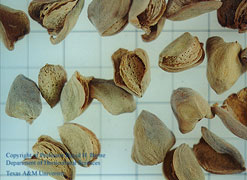


Home
Flowers &
Indoor Plants
Fruits & Nuts
Ornamentals
Vegetables
Special Topics
Resources
Glossary

|
Almond Prunus amygdalus (proo-nus a-mig-dal-us)  Click on thumbnails for larger image. |
 |
| What about it? The almond originated in southwestern Asia, spreading to northern Africa, southern Europe, America, and other parts of the world. It differs greatly from the other nut crops by being closely related to the peach, plum, apricot and other stone fruits. The leaves of this tree are bright green and narrow. The tree itself can get to be as tall as 30 feet, although semidwarf varieties are usually 10-20 feet tall. The white or pink flowers are plentiful in early spring. What is it used for? Almonds can be used in baking or eaten by themselves. Try them sliced and sauteed in butter with vegetables for a nutty, nutritious alternative to plain vegetables! Marzipan is a paste made from ground almonds that is used in some baked goods. Where does it grow? How do we grow it? Commercial production of the almond is limited to areas where mild winter and early spring conditions allow a good fruit set and where there is a long, hot, dry growing season to mature the crop, such as in California and the southwestern U.S. Almond trees need full sun, and must have well-drained soil. They are spaced 24-30 feet apart depending on the rootstock and depth of soil. Almonds bloom in early spring and should be pruned lightly each year. What are its primary problems? Diseases of the almond include brown rot, leaf scab, and shot-hole disease. Crown and root rot diseases can also be limiting factors in growing almonds. Common insects attacking the almond include the brown almond mite, red spider mite, and peach twig borer. How do we harvest and store it? Commercially, nuts are knocked to the ground and picked up by machine. Home gardeners can get away with harvesting at a much drier stage than commercial growers. People with a few trees at home will often knock nuts onto sheets and pick them up all at once, rather than try to harvest individual nuts. "Wet" nuts should be dried thoroughly for storage.
© Copyright, Department of Horticulture, Cornell University. |